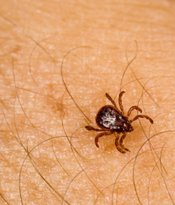Lyme Disease in Cats
"Lyme disease in cats is caused by a tick bite that attaches itself to your cat at least 24 hours. Treatment includes removing the tick the same day your cat is bitten,and shampoos and topicals that kill and prevent ticks from biting. Treatment includes antibiotics with the possible addition of homeopathic support."
Cat lyme disease is caused by a bacterial infection spread by ticks. Humans can only catch the disease from ticks, not from contact with their pets.
Cases of feline lyme disease are predominantly seen in the Northeastern and Middle-Atlantic States. There has also been an increase in cases in the Mid-West.

Picture of Tick
How Cats Get Lyme Disease
The bacteria that causes lyme disease (Borrelia burgdorferi) is found in small wild animals such as mice and deer. When ticks feed on the blood of an infected animal, they become a carrier and can then pass the bacteria on to the next animal the tick bites such as your cat.
Symptoms of Lyme Disease in Cats
Symptoms in cats (and dogs) are not as severe as the symptoms seen in humans that are infected with lyme. When a cat is infected by a lyme carrying tick, symptoms can include:
- Arthritis
- Lameness
- Joint Pain
- Joint Swelling
- Fever
- No appetite
- Dehydration
- Lethargy
- Swollen lymph nodes
If rare cases more severe symptoms will develop including:
- Kidney Disease/Failure
Diagnosis of Lyme Disease of Cats
A majority of cats that live in a region that is known for lyme disease will test positive to tests. A blood test will be used with attention paid to the red blood cell count. This is why testing alone is not a proof positive approach to the illness. Your veterinarian will thoroughly check your cat's skin to see if there are any remaining ticks.
If your veterinarian suspects lyme disease due to symptoms such as those listed above, she will start your cat on treatment and then see if she gets better.
Treatment of Lyme Disease in Cats
Antibiotics are an effective way to fight cat lyme disease. You may also want to consider a natural homeopathic remedy to support the red blood cells and liver in the body. One product that is a good source for additional research is PetAlive TF-Defense Formula which is specifically made for the natural treatment of acute lyme disease or other tick borne diseases in pets.
How to Remove a Tick from Your Cat
If you see a ticks on cats you can have it removed by your veterinarian or remove it yourself. Wear gloves, and then use tweezers at skin level to pull it out. Be sure to pull at the head and mouth, not the body as squeezing it may inject your cat with any bacteria left in the tick. Pull straight out from the body. If you see some of the mouth parts remaining behind, this is not a problem. Leave them in place. Disinfect the area with hydrogen peroxide or other cat skin care ointment.
Do not use vaseline or a match to help remove the tick as ticks will not detach themselves using these methods. Clean the area and apply an antibiotic ointment.
Remember that ticks can spread disease to humans, so wear gloves and do not touch the tick with your skin/fingers.
Please do not use your fingers to remove or dispose of the tick. We do not want you in contact with a potentially disease-carrying tick. Do NOT squash the tick with your fingers. The contents of the tick can transmit disease.
Once an embedded tick is manually removed, it is not uncommon for a welt and skin reaction to occur. A little hydrocortisone spray or hydrogen peroxide will help alleviate the irritation, but it may take a week or more for healing to take place. In some cases, the tick bite may permanently scar leaving a hairless area. This skin irritation is due to the irritating and destructive tick saliva. It is not due to the tick losing its head, literally. Do not be worried about the tick head staying in; it rarely happens. This skin irritation is due to a reaction to the tick saliva.
You should frequently check your cat for ticks. There are basically 5 types of products available that can help kill/remove/repel ticks:
Prevention of Lyme Disease in Cats |
||
|---|---|---|
|
Type of Product |
Treatment |
Products |
|
Topicals |
Applied to the back 1x a month. Popular option for tick and flea prevention. |
Frontline, FRONTLINE Plus for Cats & Kittens - kills ticks within 48 hours, often before they bite your cat. Also kills fleas. Plus version contains methoprene which is an IGR or insect growth regulator which keeps insects from reproducing. Contains fipronil. |
|
Sprays |
Sprayed on your cat's fur. Used after exposure to ticks and fleas to kill them on contact. After treatment use a product like Frontline. |
Frontline Spray. Contains fipronil. |
| Shampoo | Used to kill and remove ticks that are already on your cat. | Only select a brand made specifically for cats. The active ingredient is pyrethrins. |
|
Collars |
Need to have a good fit to be effective. A quick fitting method is to allow approximately 2 fingers should be able to be fit under the collar. |
Only buy collars that are made specifically for cats as not all collars are cat safe. |
There are vaccinations available to prevent lyme disease in cats. If
your cat is frequently outdoors and lives in a tick infested area, a
vaccine may be recommended.
References for Lyme Disease in Cats:
Washington State University
College
of Veterinary Medicine